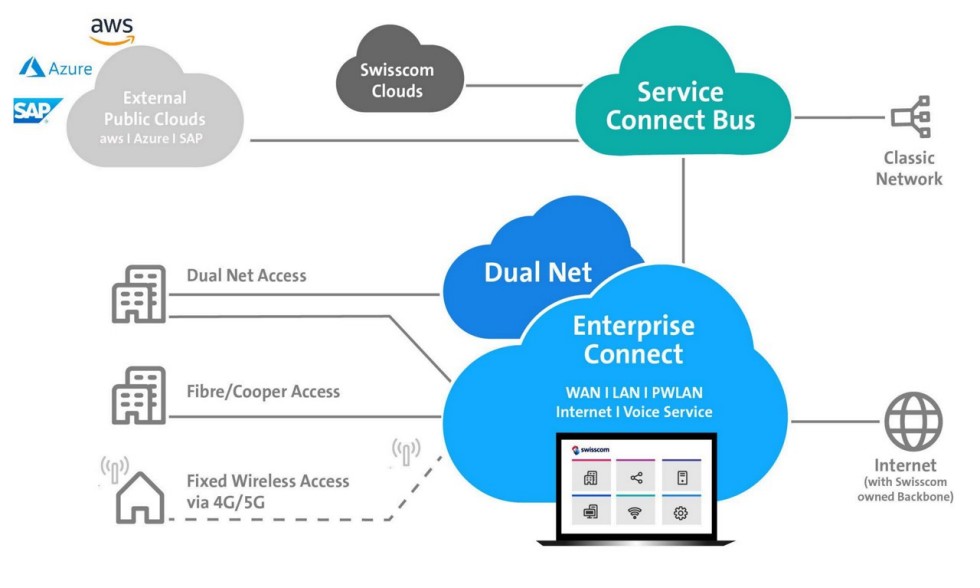Network, Internet & Landline
More flexible and more reliable cloud connectivity
Cloud computing continues to grow rapidly, requiring public data networks to carry ever-increasing quantities of data. Intelligent cloud connectivity avoids potential bottlenecks and ensures data is transferred instantaneously, securely and with the right level of network performance.
Text: Rüdiger Sellin, Specialist journalist (MAZ/SFJ), Image: AdobeStock,
Booming cloud services
Cloud computing is growing at speeds far higher than the ICT market average. An increasing number of familiar services no longer run on local computers, but on server farms somewhere else in the world.
This is a big challenge for network operators and cloud providers because cloud-based data, storage capacity, apps etc. need to be available everywhere, all the time and on any device. This demands flexible, high-performance, cost-effective network connections between all company sites and the cloud.
Cloud services are very sensitive to data transfer delays (latency) or data losses. According to Gartner, over 50% of all cloud users experience these problems and complain of mediocre performance. Global cloud providers even report that up to 90% of users are dissatisfied in some countries.
It is clear that traditional networks no longer meet the requirements of modern cloud services. Such services require data networks with high performance and elasticity levels. This is because large quantities of data often need to be transmitted immediately but quickly, something that rigid network structures with fixed bandwidths cannot achieve.
SD-WANs provide suitable cloud connectivity
A well-structured, expertly operated data network is therefore essential if the wide selection of cloud apps now available are to be used seamlessly and without disruption. How cloud services are currently accessed varies enormously.
For example, access may involve dedicated point-to-point connections which, although they offer direct access to a specific provider’s cloud servers via Point of Presence (PoP), are expensive and inflexible. Another way of accessing the cloud is over the public Internet – certainly a cheaper option, but one that comes without any performance guarantees.
Software Defined Wide Area Networks (SD-WANs), on the other hand, respond to individual network requirements proactively and in real time. They provide the best available path for the relevant cloud application through dynamic routing. SD-WANs are based on so-called Software Defined Networks (SDNs) and offer fully managed cloud connectivity with high transmission speeds and low latency, coupled with high security, availability, flexibility and elasticity.
Cloud connectivity from Swisscom
Swisscom’s Service Connect platform is a specific communication hub offering access to cloud services and forms an integral part of the Enterprise Connect offer. Via the central Service Connect bus, just a few mouse clicks can provide cloud connectivity between customers and the cloud, a traditional data centre or third-party services.

Service Connect users do not need to set up numerous expensive links to individual cloud providers. Rather, a single link via Enterprise Connect is enough. From there, the user can access the clouds they want via the Service Connect bus.
Ultra-broadband, georedundant data links guarantee secure, high-performance access to Swisscom’s own cloud as well as to external clouds (e.g. AWS, SAP or Azure cloud). This link via Enterprise Connect is more powerful and much less expensive than multiple point-to-point data connections to the PoPs of various cloud providers.
Users can also protect themselves from malicious Internet-based attacks using the inhouse DDoS Protection Service – up to OSI layer 4 or across all seven layers, depending on their requirements. DDoS complements Swisscom cloud connectivity and offers a high level of protection and security.
Summary
As a full service provider, Swisscom has extensive know-how and many years’ experience in the network and IT sector. Our ICT infrastructures are continuously being developed and improved, benefiting users of Swisscom cloud connectivity.
Swisscom is your reliable partner in the digital world. Customer data is encrypted and stored in Switzerland. This not only reduces latency, but also increases security.

Newsletter
Would you like to regularly receive interesting articles and whitepapers on current ICT topics?
More on the topic:


